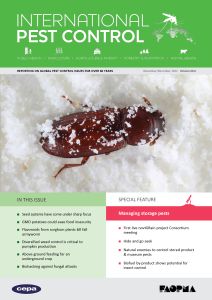The Best Strategy To Use For Eco Bed Bug Exterminators Dc
Table of ContentsOur Eco Bed Bug Exterminators Dc IdeasOur Eco Bed Bug Exterminators Dc PDFsSome Of Eco Bed Bug Exterminators DcSome Known Questions About Eco Bed Bug Exterminators Dc.Rumored Buzz on Eco Bed Bug Exterminators Dc
Since pesticides are harmful, they are also possibly harmful to people, pets, other microorganisms, and the setting. People that utilize chemicals or on a regular basis come in contact with them have to comprehend the relative toxicity, potential health results, and preventative procedures to minimize exposure to the items they use. Hazard, or threat, of utilizing pesticides is the potential for injury, or the level of danger associated with using a chemical under a provided set of problems.
Nevertheless, applicators can lessen or almost eliminate exposure-- and hence decrease threat-- by complying with the tag directions, using individual safety garments and equipment (PPE), and handling the pesticide correctly. For instance, even more than 95 percent of all chemical direct exposures originate from dermal exposure, mostly to the hands and lower arms. By using a set of unlined, chemical-resistant handwear covers, this kind of exposure can be almost removed.
The unsafe impacts that take place from a solitary direct exposure by any type of course of entry are called "severe impacts." The 4 courses of exposure are dermal (skin), inhalation (lungs), oral (mouth), and the eyes. Severe poisoning is established by taking a look at the facial poisoning, inhalation toxicity, and oral poisoning of examination pets.
The 4-Minute Rule for Eco Bed Bug Exterminators Dc
Severe toxicity is gauged as the quantity or concentration of a toxicant-- the a.i.-- needed to eliminate 50 percent of the animals in an examination population. This procedure is typically expressed as the LD50 (dangerous dosage 50) or the LC50 (lethal concentration 50). In addition, the LD50 and LC50 worths are based upon a single dosage and are tape-recorded in milligrams of pesticide per kilo of body weight (mg/kg) of the examination pet or partially per million (ppm).
The lower the LD50 or LC50 value of a chemical product, the better its poisoning to people and animals. Pesticides with a high LD50 are the least hazardous to human beings if utilized according to the instructions on the product label. The chronic poisoning of a pesticide is established by subjecting test pets to long-term direct exposure to the energetic ingredient.
The persistent toxicity of a chemical is harder than severe poisoning to determine with lab evaluation. Products are categorized on the basis of their loved one intense toxicity (their LD50 or LC50 values). Chemicals that are categorized as very hazardous (Poisoning Classification I) on the basis of either oral, facial, or inhalation poisoning should have the signal words threat and toxin published in red with a skull and crossbones sign prominently presented on the front panel of the plan label.
The intense (single dosage) dental LD50 for pesticide items in this group varies from a trace quantity to 50 mg/kg. Direct exposure of a couple of declines of a material taken by mouth can be fatal to a 150-pound person. https://www.pageorama.com/?p=ecobedbug3xt. Some chemical products have simply the signal word risk, which tells you nothing regarding the acute poisoning, simply that the product can create serious eye damage or severe skin irritability
Our Eco Bed Bug Exterminators Dc Diaries
In this classification, the severe dental LD50 varieties from 50 to 500 mg/kg. A tsp to an ounce of this product could be fatal to a 150-pound individual (exterminator). Pesticide products categorized as either a little toxic or relatively nontoxic (Toxicity Categories III and IV) are called for to have the signal word CAUTION on the chemical tag

All pesticide toxicity values, including the LD50, can be discovered on the product's Product Security Information Sheet (MSDS) - exterminator near me. Pesticide labels and MSDS can be gotten from sellers or manufactures. Furthermore, a lot of products additionally know that can be found on the web. The symptoms of pesticide poisoning can range from a moderate skin irritation to coma and even fatality.
Due to the fact that of potential wellness issues, pesticide customers and handlers should recognize the common indications and signs and symptoms of chemical poisoning. The results, or signs and symptoms, of pesticide poisoning can be generally defined as either topical or systemic.
What Does Eco Bed Bug Exterminators Dc Do?
Dermatitis, or swelling of the skin, is accepted as the most generally reported topical impact connected with pesticide direct exposure. Some individuals have a tendency to cough, wheeze, or sneeze when exposed to pesticide sprays.
This symptom usually subsides within a couple of minutes after a person is removed from the exposure to the toxic irritant. A reaction to a chemical product that creates somebody not just to sneeze and cough however also to establish severe acute respiratory system signs and symptoms is extra most likely to be a true hypersensitivity or sensitive reaction.
Systemic effects are rather various from topical impacts. They commonly occur far from the initial point of get in touch with as an outcome of the pesticide being soaked up into and distributed throughout the body. Systemic effects frequently include queasiness, throwing up, exhaustion, frustration, and intestinal conditions. In innovative poisoning cases, the individual might experience changes in heart rate, problem breathing, convulsions, and coma, which can bring about fatality.